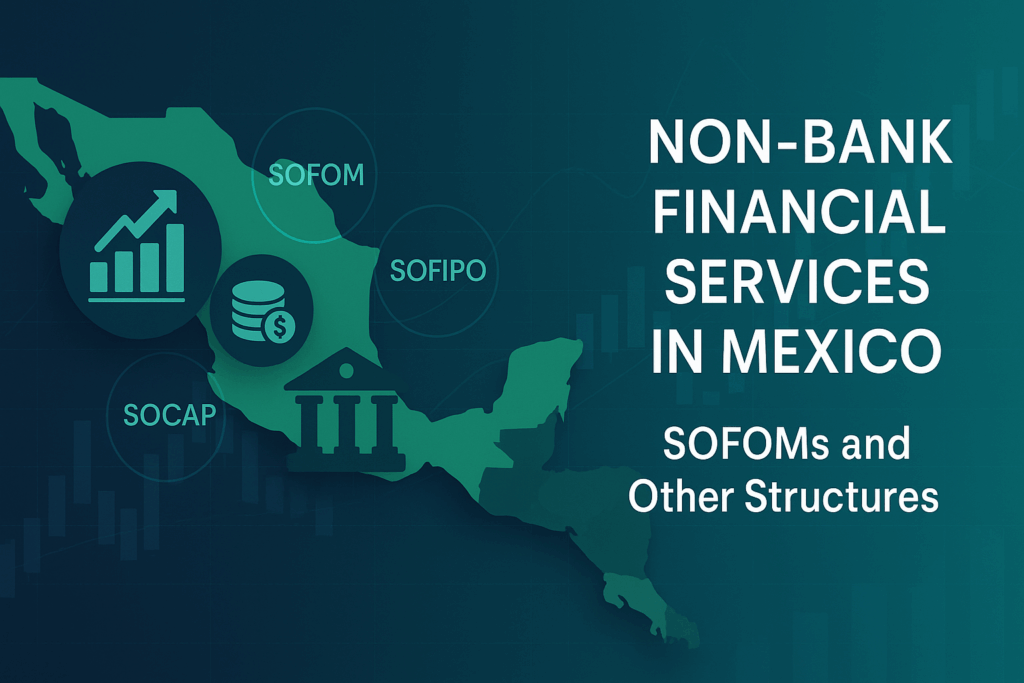Introduction: Why Non-Bank Financial Services Matter
Cross-border payments between Mexico and the United States represent one of the largest and most dynamic financial corridors in the world. According to World Bank data, Mexico has consistently ranked as the second-largest recipient of remittances globally, with over USD $63 billion sent in 2023. Much of this flow is driven by migrant workers and small businesses operating on both sides of the border. Yet despite the size of this market, the system is still fragmented, often costly, and lacking in innovation.
Traditional banks have historically dominated international transfers, but their services can be expensive, slow, and inaccessible to many customers. In this environment, non-bank financial services companies (NBFIs) — including SOFOMs (Sociedades Financieras de Objeto Múltiple) and SOFIPROs (Sociedades Financieras Populares) — have emerged as flexible, efficient alternatives. These structures allow companies to handle lending, payments, and in some cases remittances, without the heavy restrictions of a full banking license.
By leveraging these Mexican entities alongside a U.S. Money Services Business (MSB) license, entrepreneurs can create powerful cross-border platforms that meet regulatory requirements while delivering faster, lower-cost financial services.
How Non-Bank Financial Services Companies in Mexico Operate
NBFIs in Mexico operate under the supervision of the Comisión Nacional Bancaria y de Valores (CNBV) and the Ministry of Finance (SHCP). The most common structures for cross-border operators are:
SOFOM ENR (Unregulated Multiple Purpose Financial Company)
– Easiest and fastest to establish
– No fixed minimum capital (best practice: MXN 2–5 million)
– Flexible for lending, factoring, and payments
– AML/CFT registration with CNBV is required
SOFOM ER (Regulated Multiple Purpose Financial Company)
– Requires CNBV registration and ongoing compliance
– Typical capital: MXN 10 million+
– Offers greater credibility and access to institutional partners
SOFIPRO (Popular Financial Company)
– Fully regulated by CNBV, with strict prudential and capital rules (MXN 20–30 million)
– Can accept deposits and offer savings products
– Useful for remittances, local transfers, and financial inclusion
Cross-Border Payments with the U.S.: How It Works
To move funds between Mexico and the United States using an NBFI, a company typically follows this structure:
1. Customer Onboarding in Mexico – Mexican customers register with the SOFOM or SOFIPRO, completing KYC/AML checks. Accounts can be denominated in pesos and linked to local banking rails for deposits or withdrawals.
2. Transfer Execution – Funds collected in Mexico are pooled and processed by the NBFI. A U.S.-based MSB (or a Puerto Rican International Financial Entity) handles the dollar side of the transaction. Peso-to-dollar conversions are executed through FX providers or directly through institutional partners.
3. Settlement in the United States – The MSB distributes funds to U.S. bank accounts, debit cards, or wallets. For remittances, recipients may pick up cash at payout locations or receive deposits instantly.
This dual-entity structure — NBFI in Mexico + MSB in the United States — allows companies to bridge peso and dollar ecosystems legally, transparently, and efficiently.
The Market Opportunity: A Growing and Underserved Industry
Mexico’s remittance market continues to grow year after year. In 2023 alone, over 140 million transactions were made across the U.S.-Mexico corridor. Despite the size of this industry, the market is still dominated by a handful of large players such as Western Union, MoneyGram, and OXXO.
However, smaller fintech-driven companies are carving out space by offering lower fees, faster transfers, and digital-first experiences. Given the scale, there is room for dozens more NBFIs to compete. According to CNBV data, Mexico has several hundred SOFOMs registered, but only a small portion are focused on international money transmission.
By combining regulatory-approved structures in Mexico with MSB licenses in the United States, new entrants can:
– Reduce costs by bypassing legacy correspondent banking networks
– Offer real-time settlement between pesos and dollars
– Provide added services such as lending, factoring, or e-wallets
– Enhance financial inclusion by serving migrant families and SMEs
The demand is clear: the market needs more players to drive competition, innovation, and lower costs.
Integration with a U.S. MSB
The U.S. Money Services Business license (regulated by FinCEN at the federal level and state regulators individually) provides the legal foundation to conduct money transmission, foreign exchange, and prepaid services in the United States.
When integrated with a Mexican NBFI:
– Regulatory Alignment – Mexican AML/KYC compliance feeds into U.S. FinCEN requirements. Both entities coordinate to monitor suspicious activity and report transactions.
– Operational Synergy – The Mexican NBFI handles peso-side onboarding and payments. The U.S. MSB manages dollar custody, U.S. settlement accounts, and ACH/wire connectivity.
– Strategic Expansion – Cross-border services can extend beyond remittances to include merchant payments, payroll, SME financing, and trade-related FX. Integration with a Puerto Rican International Financial Entity (IFE) or U.S. correspondent bank further strengthens credibility.
This dual structure creates a seamless, bi-national payments platform that can handle high transaction volumes while remaining compliant in both jurisdictions.
Conclusion: Building the Future of Cross-Border Finance
The U.S.-Mexico financial corridor is too large and too important to remain dominated by legacy providers. With over USD $63 billion flowing annually and growing demand from businesses and consumers alike, there is a clear opportunity for non-bank financial institutions in Mexico to play a bigger role.
By establishing a SOFOM or SOFIPRO in Mexico and linking it with a U.S. MSB, financial entrepreneurs can create efficient, scalable, and legally compliant cross-border payment solutions. This model not only reduces costs but also expands access, empowering SMEs, migrants, and underserved communities on both sides of the border.
As regulatory clarity improves in 2025, now is the time for innovators to step in, scale their operations, and help reshape the future of cross-border payments between Mexico and the United States.

